Written by: Neil Murphy, Toronto, ON Canada
Email: neilsmurphy@outlook.com
Introduction
AIM: A system for practicing and learning how to adjust the target line of your shot to account for throw over a wide range of shots.
AIM is completely derived from the work of Dr. Dave Alciatore in particular as found in his technical proof TP A.14. If you wish to learn more about throw Dr. Dave has an excellent series of articles located here:
“Throw – Part I: introduction” (August, 2006).
“Throw – Part II: results” (September, 2006).
“Throw – Part III: follow and draw effects” (October, 2006).
“Throw – Part IV: spin-induced throw” (November, 2006).
“Throw – Part V: SIT speed effects” (December, 2006).
“Throw – Part VI: inside/outside english” (January, 2007).
“Throw – Part VII: CIT/SIT combo” (February, 2007).
“Throw – Part VIII: spin transfer” (March, 2007).
“Throw – Part IX: spin transfer follow-up” (April, 2007).
“Throw – Part X: the big picture” (May, 2007).
“Throw – Part XI: everything you ever wanted to know about throw” (June, 2007).
“Throw – Part XII: calibration, and hold shots” (July, 2007).
This paper assumes you have some working knowledge of throw. If not, you can review the topic on Dr. Dave’s summary page here.
Furthermore, with the exception of center ball hit shots, you will need some knowledge of squirt and swerve. This paper assumes you have enough knowledge of this topic to shoot with sidespin. If you would like more information on this topic, please take a moment to access some of the great resources online. Mike Page of Fargo has an excellent video on squirt and swerve.
What is AIM?
AIM is a system that provides you with the knowledge to adjust your target line or aim line for throw due to the friction between the cue ball and the object ball. The amount of throw varies from 0 – 5 degrees for a wide variety of shots. AIM will allow you to determine the shot you wish to take, calculate the amount of throw that it will cause, and then to adjust your AIM line accordingly to result in greater accuracy in potting your shots. Two elements of the system; draw shots and shots with english/sidespin/spin induced throw will be explained at the end of the article.
What are the steps in the AIM process?
The following outlines the pre-shot routine for AIM.
Step 1: Determine your shot in terms of:
- Type of shot: natural rolling or stun (draw will be addressed at the end of the article.)
- Speed: slow – medium – fast
- English (will be discussed at the end of the article)
Step 2: Determine the angle of the shot from the target line to the nearest 15 degrees.
Step 3: Calculate the amount of throw as a percentage of maximum using chart information.
Step 4: Find the line of aim off the target line using the throw information.
Step 1: Determine your shot
We will start with center ball hit shots. Given the layout of the table, determine where you will pocket the object ball and where you would like the cue ball to come to rest. The key factors you need to determine how to get the cue ball to its destination are the type of shot stun or natural rolling, and the speed of the shot. (we will address draw and english at the end of the article)
Some examples:
Slow stun shot.
¾ of top speed (medium fast), natural rolling shot.
½ or medium speed, center ball hit, stun shot
½ speed natural rolling shot.
Step 2: Determine the angle to the shot in 15 degree increments
The angle of the shot to the target line has a critical impact on the amount of throw that will transfer to the object ball. AIM works in units of 15 degrees to the line of aim. This makes it easier to remember throw data and also, once you have practiced AIM at 15 degree increments it is very easy to extrapolate in between.
Therefore, you will need to be able to identify shot angles from the target line of 15, 30, 45, 60, 75 degrees. You need to be able to determine the angle with reasonable accuracy. For more information on how to do this I refer you to this page ‘Estimating Cut Angle’
Step 3: Determine throw
Using the speed of the shot, the type of shot, and the angle of the shot, it is now possible to determine the throw for this center ball hit in terms of the percentage of maximum throw. The maximum amount of throw is five degrees. AIM determines the amount of throw as a percent of the maximum.
To find out the maximum throw, refer to the two charts below. The left is for ‘Stun’ shots, and the right is for ‘Natural Rolling’ shots.
On the ‘x’ axis is the amount of throw the shot will have as a percent of the maximum. The y axis goes up in increments of 15 degrees from the target line. The red line and the teal coloured bars, which are both the same information, show throw results for slow and fast shots, with the bars being the range from minimum to maximum throw as a function of speed, and the middle red line being a medium speed shot.
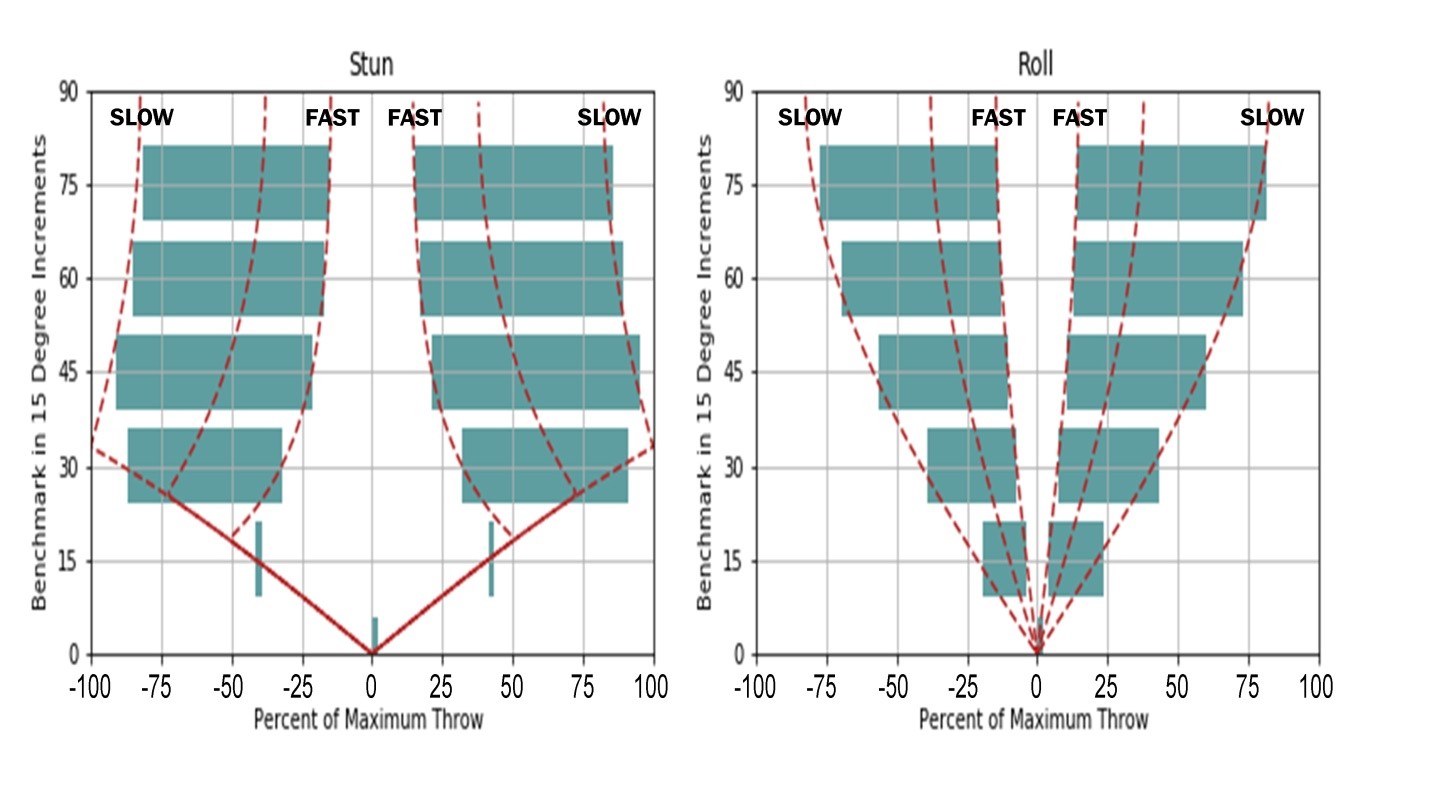
It is important to have these chart images reasonably committed to memory. To assist this, the attached web page has two animated gifs and 3D plots.
It is probably best to work through some examples.
| Type of Shot | Throw % of maximum |
| Stun shot, medium speed, 15 degrees. | 41 |
| Rolling shot, slow speed, and 45 degrees. | 58 |
| Stun shot, slow speed, 30 degrees. | 89 |
| Stun shot, fast speed, 15 degrees | 41 |
| Stun shot, slow speed, 15 degrees | 41 |
| Stun shot, medium speed, 15 degrees | 41 |
| Rolling shot, slow speed, 60 degrees | 71 |
| Rolling shot, medium speed, 45 degrees | 27 |
Step 4: Select the aim line
Maximum throw occurs at a half ball hit, center ball hit, slow stun shot, resulting in a deflection of approximately five degrees.
Therefore, since at this stage we know the percent of maximum from step 3, we now need an easy system to adjust the aim line based on this information while at the table. The following are two methods:
Method 1:
Along the line of aim, visualize another ball (throw ghost ball) with 10 inches between the front edge of the throw ghost ball and the back edge of the object ball. The line from the right most or left most edge of this throw ghost ball when viewed through the center of the object ball represents the maximum throw line. To determine the line of aim, simply divide the half of the ghost ball on the opposite side of your shot by the percent determined in step three, then view this through the center of the object ball to determine your line of aim. Pick the spot on the cushion that the new line point to and aim for that spot.
The following example shows a 30 degree cut shot with throw adjusted to 41 percent of maximum.
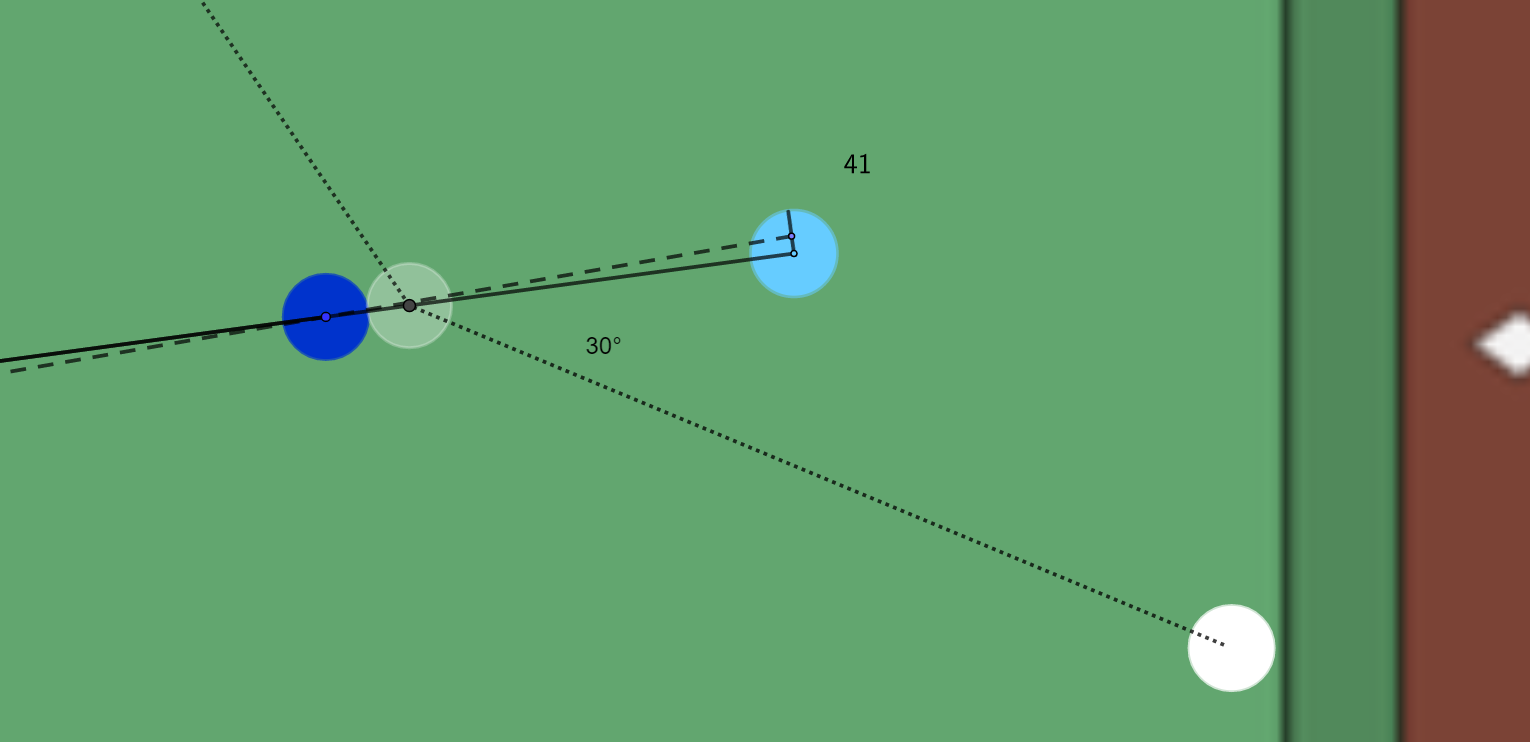
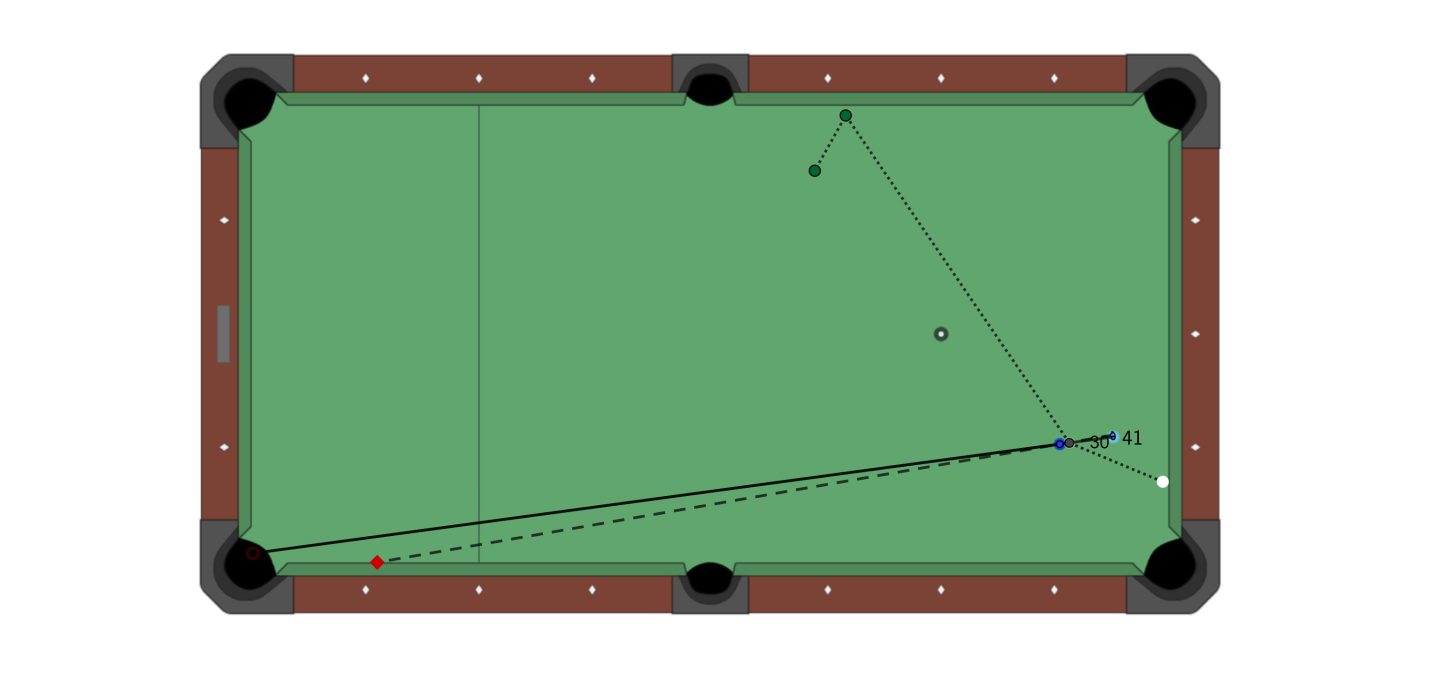
The red dot along the cushion is the new aim line.
Method 2:
I have an old predator shaft with a 12.75 mm tip. At 11 ¼ inches back from object ball (or about 10 inches from the back edge of the Object ball) along the line of aim, if I place my tip on the target line, then the right side of the tip will be 25% of maximum throw.
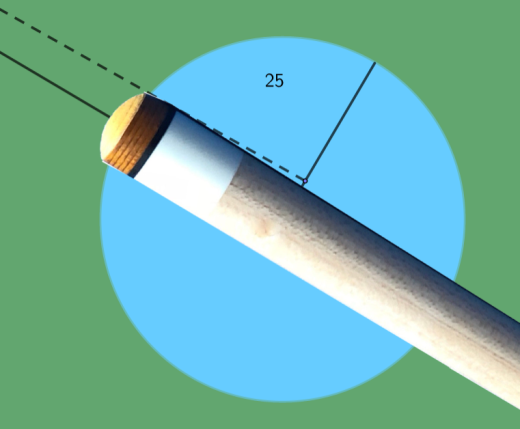
If I put the left side of the tip on the line of aim, then the right side of the tip is 50% of maximum throw.
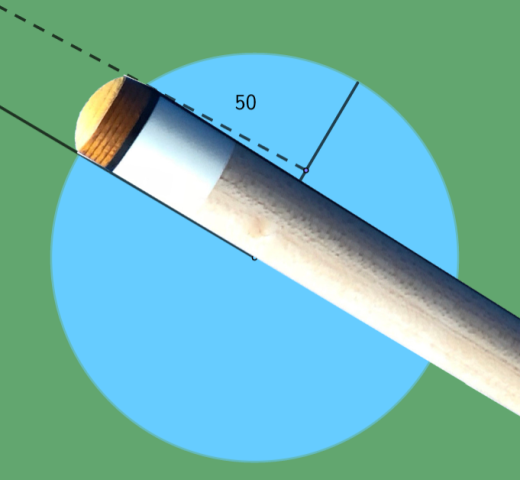
I can then roll the cue for 75 and maximum as needed.
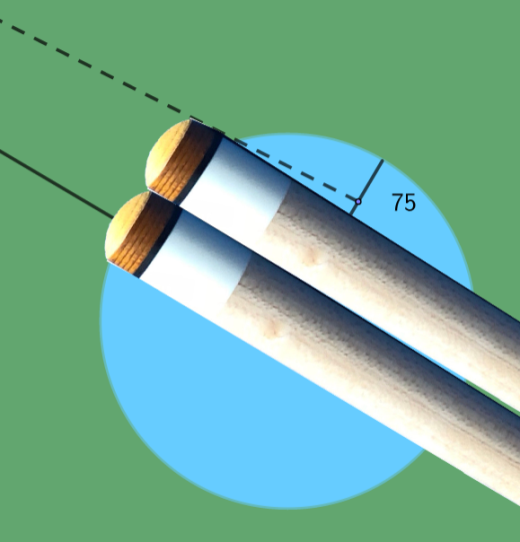
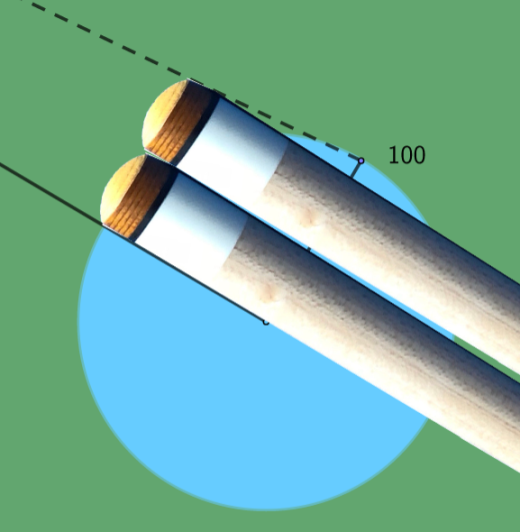
This provides better accuracy but is a bit more cumbersome. Use the following chart to determine how far back from the object ball your cue tip needs to be to measure the throw angle. Subtract 1.125 inches if measuring from the back of the object ball.
| Tip Size | Inches from OB |
| 11.00 | 9.70 |
| 11.25 | 9.93 |
| 11.50 | 10.15 |
| 11.75 | 10.37 |
| 12.00 | 10.59 |
| 12.25 | 10.81 |
| 12.50 | 11.03 |
| 12.75 | 11.25 |
| 13.00 | 11.47 |
| 13.25 | 11.69 |
| 13.50 | 11.91 |
| 13.75 | 12.13 |
Draw Shots
Draw shots can usually be treated the same as natural rolling shots. However, if your draw shot is a partial draw, or any draw shot that doesn’t have full back spin when striking the object ball, you must adjust your throw so that it is closer to the stun angle, not the rolling shot. Generally speaking though, one can use natural rolling to determine the amount of throw on a draw shot.
Sidespin, english, and spin induced throw
This is where it gets a bit tricky. So far this article has discussed center ball hits. This has laid the foundation of the AIM system. We will make up a general rule for using english that will blend in with the AIM system.
AIM is a system that centers itself on gearing english when accounting for sidespin. This is the amount of english/spin on the cue ball that results in no sideways friction on the object ball. For an excellent article on gearing English you can go here.
The following image shows a cue ball with a gearing english chart centered in the middle. The gearing english is in 15 degree increments. The outside of the white circle is the approximate miscue limit. The light blue circle is the rest of the cue ball.
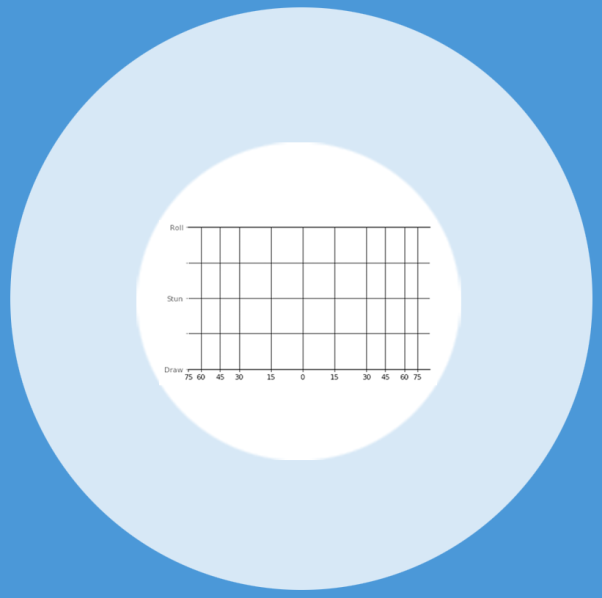
As mentioned, AIM is a system of 15 degree increments. We will convert the tip offset from center ball hit into an equivalent of 15 degrees chunks of cut induced throw. The following is a conversion chart for various tip sizes.

I personally shoot with a 12.75 mm tip and use the following rounded figures:
| Angle tip 15 25% 30 50% 45 65% 60 80% 75 90% |
So for example, if I’m shooting with a center ball hit, then my sidespin adjustment would be none. Using a 25% tip hit inside English, I would add 15 degrees to my throw calculation. If I’m shooting with 50% of my tip outside English, I’m going to subtract 30 degrees from throw calculation.
Let’s run through the examples above but add some degree of english.
| Type of Shot | Cut Angle | English | Total Angle | Throw % of maximum |
| Stun shot, medium speed, ¼ tip inside english | 15 | 15 inside | 30 | 67 |
| Rolling shot, slow speed, ½ tip outside english | 45 | 30 outside | 15 | 21 |
| Stun shot, slow speed, ¼ of a tip outside english | 30 | 15 outside | 15 | 41 |
| Stun shot, fast speed, .65% of tip inside english | 15 | 45 inside | 60 | 25 |
| Stun shot, slow speed, ½ tip inside english | 15 | 30 inside | 45 | 93 |
| Stun shot, medium speed, ½ outside english | 15 | 30 outside | -15 | -41 |
| Rolling shot, slow speed, .8% outside english | 60 | 60 outside | 0 | 0 |
| Rolling shot, medium speed, ¼ tip inside english | 45 | 30 inside | 75 | 37 |
The following examples walk you through the process step by step.
- Stun Slow 30
- Rolling Slow 45 Inside English
- Rolling Long Rail Slow 30 No English
- Stop Shot Throw the Object Ball into the Pocket
Interesting Discoveries
When playing with the tools developed for this exercise, it became possible to answer a few interesting questions.
First, what is the largest area that one can aim center pocket, using a shot with maximum throw, and still be sure to pocket the ball without making adjustments. What about cheating the pocket and aiming to the inside corner?
Looking at the following diagram, the inner area in blue represents the rough area where you can shoot center pocket and not have to worry too much about throw. The larger circle represents the area if you are aiming at the inside corner of the pocket, you will not need to worry too much about throw.
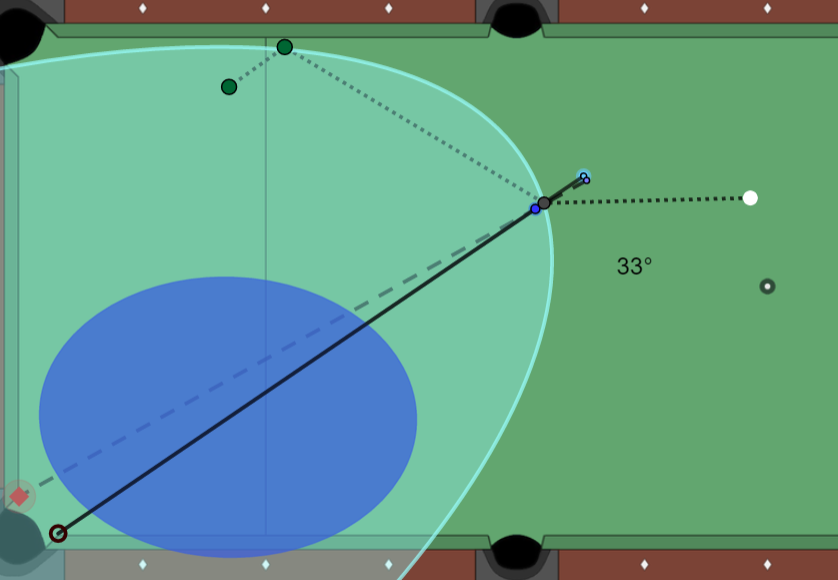
I say worry ‘too much’ because there is still one problem. Take the shot in the diagram, if you aim this shot for the inside corner and aim correctly, then the shot will still go in. However, if you are even slightly off in your aim toward the inside of the pocket when executing the shot, then you are sure to miss. Using the AIM system will still give you a higher probability of pocketing the ball. As the diagram shows below, if you miss slightly in aiming the shot, you still have a good probability on either side to make the pot.
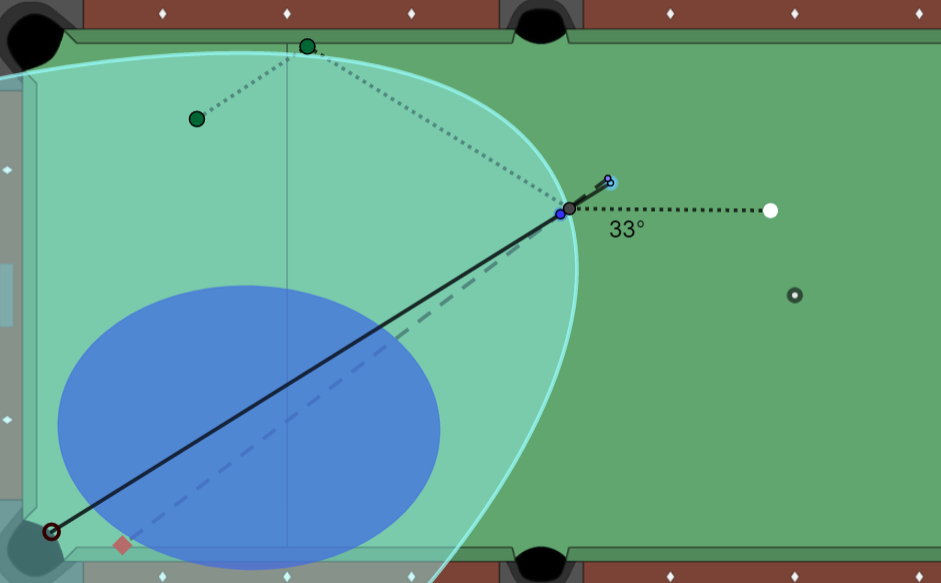
Another interesting discovery it to observe why sharp angled side pocket shots are so challenging. The obvious answer of course is that the side pocket opening narrows drastically as the shot moves closer to the side rail. But if we view maximum throw even over this short distance, it becomes very clear why these shots are so hard.

Even with less angle, it is easy to see the challenges of making side shots.
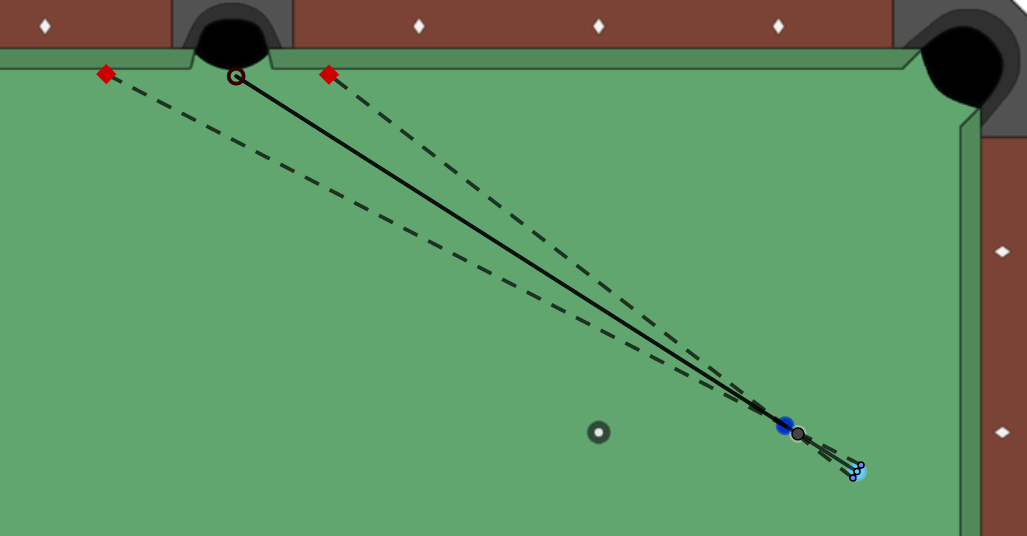
Conclusion
I originally set out to make a system that would be easy to use at the table. AIM can be easy to use at the table, but I will admit, it takes some practice and getting used to. While not a simple system, neither is trial and error. By taking the time to use this tool, hopefully you will become a player more comfortable taking those difficult to gauge shots. I know I have.
